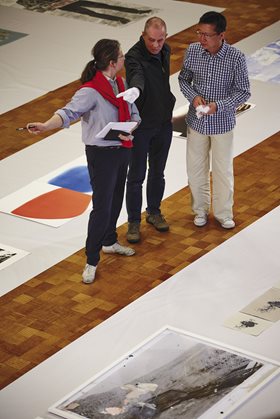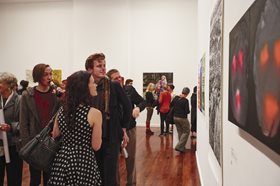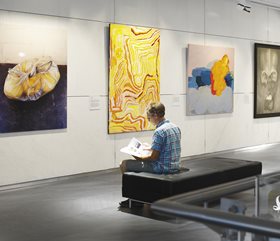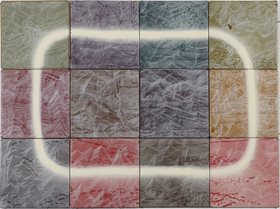 Way out West
Way out West
Sandra Murray
Is there something unique about the art of Western Australia to that from other Australian states? What’s the opinion ‘over east’? Is there a divergence between art from the centre and that on the periphery? I interviewed two people who were recently involved in judging visual art awards in Perth for their perspective, Justin Trendall and Kelly Gellatly. Both live outside WA and so proffer a fresh viewpoint to this discussion.
The Fremantle Arts Centre Print Award for prints and artists’ books is a high profile, established award that has developed a considerable reputation since its inception in 1976. The exhibition and award presents the best in contemporary Australian print media and charts the developments and shifting boundaries of this medium.
Last year Justin Trendall, Senior Lecturer at Sydney College of the Arts, The University of Sydney was one of its three judges, a particularly apt choice as he grew up in Perth. Trendall attended the Special Arts Program at Applecross Senior High School then studied Fine Arts at Curtin University. He has an extensive national exhibition record, focussing on a combination of drawing, photography, screen printing and Lego.
Trendall returns regularly to WA to keep in touch with family. This enduring link has kept him contemplating over the years about how the two cities differ culturally and how artists fare in each; as part of the judging panel he had the opportunity to reflect on this. As a national survey exhibition the 38th Fremantle Arts Centre Print Award supported by Little Creatures Brewing provided an overview that lends itself to such speculations. There was a strong contingent of entries from WA, plus a substantial number of interstate works; it was a genuine national survey.
 The judges’ final selection of 51 works from some 300 entries had a significant proportion of artists, notably 19, from WA. Trendall found this intriguing given how closely focused the judges’ approach was. Their discussions were strictly about the work and not the artist’s reputation. Interestingly, a WA artist, Alex Maciver, won the $15,000 Major Acquisitive Prize in 2013. The last time the Award was won by a WA artist was 2002 when Poppy van Oorde-Grainger took out the prize.
The judges’ final selection of 51 works from some 300 entries had a significant proportion of artists, notably 19, from WA. Trendall found this intriguing given how closely focused the judges’ approach was. Their discussions were strictly about the work and not the artist’s reputation. Interestingly, a WA artist, Alex Maciver, won the $15,000 Major Acquisitive Prize in 2013. The last time the Award was won by a WA artist was 2002 when Poppy van Oorde-Grainger took out the prize.
The solid presence of WA artists in the award confirmed Trendall’s opinion as an artist and teacher. “There is a certain evenness in contemporary art production; that the information age really is beginning to blur centre/periphery differences.” Trendall observed, “Part of this new equation may be evidenced by the fact that the WA work was not recognisably different in terms of its concerns or approach; it was strong work but not distinctly local.”
Kelly Gellatly is Director of the Ian Potter Museum of Art at The University of Melbourne. She was previously Curator of Contemporary Art (Australian and International) at the National Gallery of Victoria and has also worked as a curator at Heide Museum of Modern Art and the National Gallery of Australia. Gellatly is one of the 2014 judges of the esteemed Basil Sellers Art Prize. Last year she was one of three judges of the Bankwest Art Prize.
 The Bankwest Art Prize was established in 2001 and is one of the State’s most generous visual arts awards exclusively for WA artists. Criteria for making the selection of finalists have focused on two-dimensional art that reflects a contemporary approach, is conceptually refined and innovative; with the winning artist receiving $30,000. Their artwork becomes part of the Bankwest Art Collection; a collection of some 500 works by Western Australian artists. Since 2012 the Prize has been shown in the Bank’s new art gallery at Bankwest Place, Murray Street, Perth; one of the few corporate art galleries open to the public nationally. The 2013 Prize featured the work of 19 contemporary Western Australian artists chosen from a field of 110 applicants.
The Bankwest Art Prize was established in 2001 and is one of the State’s most generous visual arts awards exclusively for WA artists. Criteria for making the selection of finalists have focused on two-dimensional art that reflects a contemporary approach, is conceptually refined and innovative; with the winning artist receiving $30,000. Their artwork becomes part of the Bankwest Art Collection; a collection of some 500 works by Western Australian artists. Since 2012 the Prize has been shown in the Bank’s new art gallery at Bankwest Place, Murray Street, Perth; one of the few corporate art galleries open to the public nationally. The 2013 Prize featured the work of 19 contemporary Western Australian artists chosen from a field of 110 applicants.
Gellatly’s role as a judge of the 2013 Bankwest Art Prize enabled her to visit Perth after a hiatus of several years. While her brief stay only allowed her to dip into the local contemporary arts scene, she was nevertheless, “…impressed by its diversity, vibrancy and ambition.” The work she viewed both in the prize and elsewhere was, she says, “…conceptually rigorous; produced by artists committed to their own unique journeys, rather than chasing or adhering to fashions or fads.”
While much of the art reflected, “…to greater or lesser degrees the specificities of the geographical, physical and cultural environment in which it was made, it was in no way parochial, and instead embodied a level of complexity and sophistication that placed it squarely within a global context.”
 Furthermore she relished the strength and presence of Indigenous art in the mix with other artists in the Bankwest Art Prize (as it is with the Fremantle Arts Centre Print Award), rather than as a stand-alone concept or prize. The Indigenous artists, both urban and regional, were exhibited alongside their non-indigenous peers.
Furthermore she relished the strength and presence of Indigenous art in the mix with other artists in the Bankwest Art Prize (as it is with the Fremantle Arts Centre Print Award), rather than as a stand-alone concept or prize. The Indigenous artists, both urban and regional, were exhibited alongside their non-indigenous peers.
Did Gellatly consider the art disparate to Melbourne? No, instead artists from both places shared “…a conceptual rigour, a willingness to be brave, not bound by commercial restraints.” Indeed she expressed that the artists selected for the prize were at the forefront of contemporary art in Western Australia, and overall the works were of a very high standard with exceptional qualities, especially the winning work by Susanna Castleden.
What Gellatly did perceive as distinct is the limited exposure available for artwork exhibited in WA; it can be restrictive for an artist operating in WA apart from their online presence. As Trendall concurs, “There are still real differences attached to geographic locations and there are clearly advantages to being based in cities like Melbourne and Sydney with their flagship institutions and larger buying publics. Yet what may have been a disadvantage has softened, like the disadvantage of Australia being peripheral to the art centres of the world.” Additionally there are many positives to being distant from the centre, such as cheaper studio space and less pressure to conform to current fashions.
Both Gellatly and Trendall experienced a sense of self confidence in the WA art scene that defies the archaic concept of provincialism.
Moreover both judges commented on the new artist run initiatives in Perth; the positive initiatives to foster a creative community; and the surge of new activity arising in part from the closure of various commercial galleries. Geographical isolation need not be a hindrance, WA’s extraordinary contemporary music scene is another example of its flourishing creativity.
Has the frontier mentality in the West played out? As a previous Sydney-sider, I recall my fellow colleagues thinking little about Western Australia before moving here 25 years ago, and am not sure that sentiment has changed greatly in the Eastern States beyond the West’s reputation for FIFO, cashed-up bogans, mining magnates, Bondy and his mates. Still, the pressing sense of remoteness in ‘the world’s most isolated city’ has dissipated considerably with the impact of the internet and cheaper airfares, it is more a psychological difference if at all. So now we have a burgeoning connected national and global arts community, yet the opportunity for artists from Perth to exhibit on the other side of their country is still too rare and cost prohibitive, it surely deserves more support. Artists’ careers are still challenged in Perth, to make it to that next level they are pushed to expand beyond the state border.
Sandra Murray is the Art Curator for Bankwest; most recently she was Head Curator at Fremantle Prison for nine years. She moved from Sydney in 1989 to take up the position as the inaugural Curator of the Lawrence Wilson Art Gallery, UWA. Sandra holds a BA (Honours) in Fine Arts from The University of Sydney and a Masters in Philosophy from The University of Western Australia.
This article featured in the Artsource Newsletter, Winter 2014.